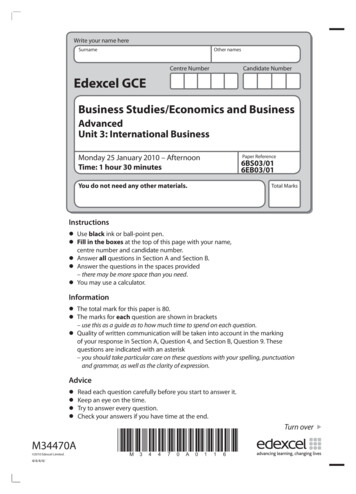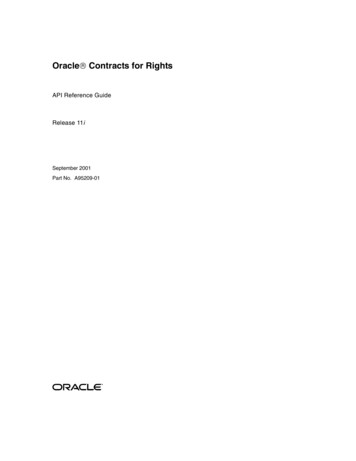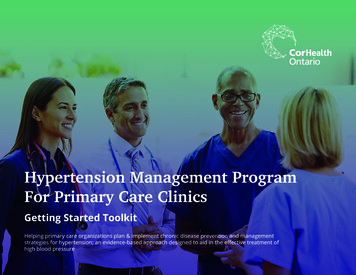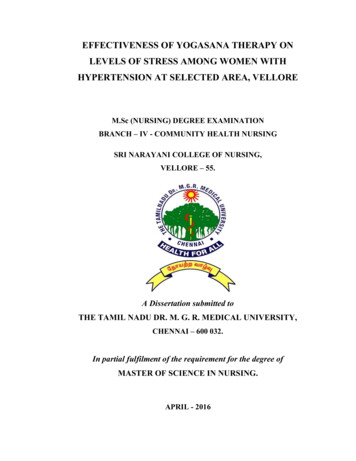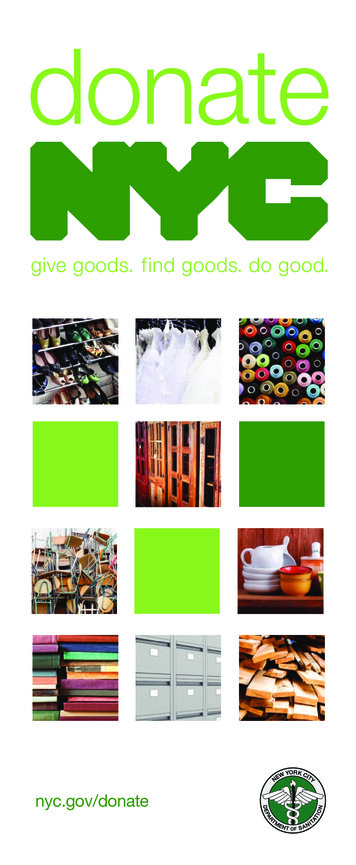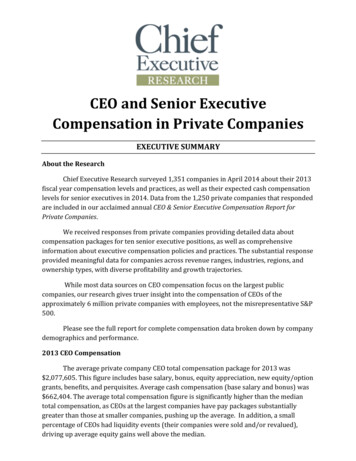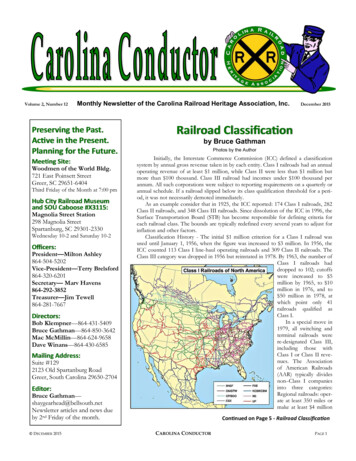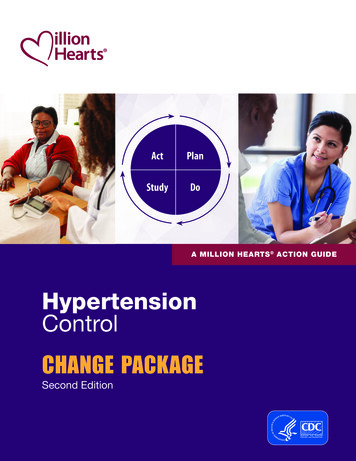
Transcription
ActPlanStudyDoA MILLION HEARTS ACTION GUIDEHypertensionControlCHANGE PACKAGESecond Edition
AuthorsThe Million Hearts Hypertension Control Change Package was originally conceptualized and authored by Hilary K. Wall, MPH*; Rikita Merai, MPH*; JeromeA. Osheroff, MD, FACP, FACMI (TMIT Consulting, LLC); and Brita Roy, MD, MPH, MS (Robert Wood Johnson Foundation Clinical Scholars Program at YaleUniversity) in 2015. The 2020 revision was authored by Hilary K. Wall, MPH*; Lauren Owens, MPH (IHRC, Inc.)*; and Kaitlin Graff, MSW, MPH.*ContributorsThe following individuals contributed subject matter expertise, identified tools and resources, and reviewed the document: Jerome A. Osheroff, MD, FACP,FACMI (TMIT Consulting, LLC); Meg Meador, MPH, C-PHI, CPHQ (National Association of Community Health Centers); Michael Rakotz, MD, FAHA, FAAFP(American Medical Association); and Elizabeth Montgomery (National Kidney Foundation).ReviewersThe following individuals provided review and feedback on the document: Joseph Vassalotti, MD (National Kidney Foundation); Laurence Sperling, MD,FACC, FACP, FAHA, FASPC*; Betsy Thompson, MD, MSPH, DrPH, RADM, U.S. Public Health Service*; Judy Hannan, RN, MPH*; Salvatore J. Lucido, JD, MPA*;and Mary G. George, MD, MSPH, FACS, FAHA.*Graphic Design and Editorial AssistanceGraphic and HTML design support was provided by Booker Daniels, MPH*; Susan Davis (Northrop Grumman Corporation)*; Jessica Spraggins, MPH*;and Palladian Partners, Inc.Website Hosting AssistanceWebsite hosting support of tools and resources was provided by the National Association of Chronic Disease Directors.We would like to extend special thanks to the following organizations for developing the tools and resources that are showcased in the change package: Agency for Healthcare Research andQuality (AHRQ) Alexander Valley Healthcare, Cloverdale, CA Altura Centers for Health (previously TulareCommunity Health Clinic), Tulare, CA American College of Cardiology (ACC) American College of Preventive Medicine (ACPM) American Heart Association (AHA) American Medical Association (AMA) American Medical Group Association (AMGA) American Medical Group Foundation (AMGF) American Society of Health-System Pharmacists ARcare/KentuckyCare, Augusta, AR Association of State and Territorial HealthOfficials (ASTHO) Beth Israel Deaconess Medical Center, Boston, MA Broadway Internal Medicine, Queens, NY California Health Care Foundation Cardi-OH: Ohio Cardiovascular Health Collaborative Cheshire Medical Center/Dartmouth-Hitchcock,Keene, NH Cigna Cleveland Clinic Community Health Centers, West Valley City, UT Consumer Reports Cornerstone Health Care (now Wake ForestBaptist Health), Winston-Salem, NC Ellsworth Medical Clinic, Ellsworth, WI Esperanza Health Centers, Chicago, IL Exercise is Medicine Family Practice Notebook Food and Drug Administration (FDA) Golden Valley Health Centers, Merced, CA Grace Community Health Center, Gray, KY Green Spring Internal Medicine, Lutherville, MD Health Resources & ServicesAdministration (HRSA) HealthPartners (previously Park Nicollet),Bloomington, MN Healthy Hearts Northwest HealthyHearts NYC Heart Health Now! North Carolina Cooperative Henry Ford Health System, Detroit, MI HIPxCHANGE Hypertension Canada Institute for Healthcare Improvement (IHI) Intermountain Healthcare, Salt Lake City, UT Jennifer Brull, MD, Post Rock Family Medicine,Plainville, KS Johns Hopkins University Kaiser Permanente Kaiser Permanente Mid Atlantic States Kaiser Permanente Northern California Kaiser Permanente Southern California Kansas Healthcare Collaborative La Maestra Community Health Centers, CityHeights, CA Marshfield Clinic Health System, Marshfield, WI Mercy Clinics, Inc., Des Moines, IA Michael Rakotz, MD, FAHA, FAAFP, NorthwesternMedical Group, Chicago, IL (now with AMA) Minnesota Board of Nursing Minnesota Department of Health Move Your Way National Association of Community HealthCenters (NACHC) National Heart, Lung, and Blood Institute (NHLBI) National Institute of Diabetes and Digestive andKidney Diseases (NIDDK) National Kidney Disease Education Program National Kidney Foundation (NKF) Neighborhood Healthcare, San Diego/RiversideCounties, CAFor More InformationHilary K. Wall, MPHDivision for Heart Disease and Stroke PreventionCenters for Disease Control and Preventionhwall@cdc.govCenters for Disease Control and PreventionMillion Hearts Hypertension Control Champions are shown in red* New England QIN-QIO New West Physicians, Golden, CO New York City Department of Health andMental Hygiene (NYC DOHMH) New York City Health & Hospitals (NYC Health& Hospitals) NorthShore Health Centers, Northwest IN Open Door Family Medical Centers, Ossining, NY Penn Medicine Department of OBGYN’s HeartSafe Motherhood Program Plymouth Family Physicians, Plymouth, WI Premier Medical Associates, Monroeville, PA Quality Insights (previously West VirginiaMedical Institute) Redwood Community Health Coalition,Petaluma, CA Reliant Medical Group, Worcester, MA Rush University Medical Center, Chicago, IL Sanford Health, Sioux Falls, SD Script Your Future Sharp Rees-Stealy Medical Group, San Diego, CA Sinai Urban Health Institute Target: BP The Office of the National Coordinator forHealth Information and Technology (ONC) ThedaCare, Northeastern WI Trinity Clinic-Whitehouse, TX University of Texas Medical Branch UVM Medical Center (previously Fletcher AllenHealth Care/University of Vermont), Burlington, VT Vermont Department of Health Washington State Department of Health Whitney M. Young, Jr. Health Center, Albany, NY Zufall Health, Dover, NJSuggested CitationCenters for Disease Control and Prevention. Hypertension ControlChange Package (2nd ed.). Atlanta, GA: Centers for Disease Control andPrevention, U.S. Department of Health and Human Services; 2020.
ContentsHypertension Control Change Package – Quick Reference . . . . . . . . . . . . . . . . . . . . . . . . . . . . . . . . . . . . . . . . . . . . . . . . . . . . . 1What Is the Hypertension Control Change Package?. . . . . . . . . . . . . . . . . . . . . . . . . . . . . . . . . . . . . . . . . . . . . . . . . . . . . . . . . . . .3Figure 1. Hypertension Control Change Package Focus Areas . . . . . . . . . . . . . . . . . . . . . . . . . . . . . . . . . . . . . . . . . . . . . . . .3What’s New in This Version of the Hypertension Control Change Package?. . . . . . . . . . . . . . . . . . . . . . . . . . . . . . . . . . . . . . .3Figure 2. Comparison of Blood Pressure Classification Thresholds, JNC 7, and the 2017 ACC/AHA Guideline . . . . .4How Can I Use the Hypertension Control Change Package?. . . . . . . . . . . . . . . . . . . . . . . . . . . . . . . . . . . . . . . . . . . . . . . . . . . . .5Figure 3. Institute for Healthcare Improvement (IHI) Model for Improvement . . . . . . . . . . . . . . . . . . . . . . . . . . . . . . . . .5How Do I Measure Quality Improvement Efforts?. . . . . . . . . . . . . . . . . . . . . . . . . . . . . . . . . . . . . . . . . . . . . . . . . . . . . . . . . . . . . . .7Figure 4. Example of a Run Chart – Grace Community Health Center . . . . . . . . . . . . . . . . . . . . . . . . . . . . . . . . . . . . . . . .7Change Concepts, Change Ideas, and Tools and Resources . . . . . . . . . . . . . . . . . . . . . . . . . . . . . . . . . . . . . . . . . . . . . . . . . . . . 8Table 1. Key Foundations . . . . . . . . . . . . . . . . . . . . . . . . . . . . . . . . . . . . . . . . . . . . . . . . . . . . . . . . . . . . . . . . . . . . . . . . . . . . . . . . . 8Table 2. Equipping Care Teams . . . . . . . . . . . . . . . . . . . . . . . . . . . . . . . . . . . . . . . . . . . . . . . . . . . . . . . . . . . . . . . . . . . . . . . . . . . 12Table 3. Population Health Management . . . . . . . . . . . . . . . . . . . . . . . . . . . . . . . . . . . . . . . . . . . . . . . . . . . . . . . . . . . . . . . . . 15Table 4. Individual Patient Supports . . . . . . . . . . . . . . . . . . . . . . . . . . . . . . . . . . . . . . . . . . . . . . . . . . . . . . . . . . . . . . . . . . . . . . 18Appendix A: Additional Quality Improvement Resources . . . . . . . . . . . . . . . . . . . . . . . . . . . . . . . . . . . . . . . . . . . . . . . . . . . . . 22Appendix B: Hypertension Control Case Studies. . . . . . . . . . . . . . . . . . . . . . . . . . . . . . . . . . . . . . . . . . . . . . . . . . . . . . . . . . . . . . 23Acronyms. . . . . . . . . . . . . . . . . . . . . . . . . . . . . . . . . . . . . . . . . . . . . . . . . . . . . . . . . . . . . . . . . . . . . . . . . . . . . . . . . . . . . . . . . . . . . . . . . . 24References . . . . . . . . . . . . . . . . . . . . . . . . . . . . . . . . . . . . . . . . . . . . . . . . . . . . . . . . . . . . . . . . . . . . . . . . . . . . . . . . . . . . . . . . . . . . . . . . . 25Website addresses of nonfederal organizations are provided solely as a service to readers. Provision of an address does notconstitute an endorsement for this organization by CDC or the federal government, and none should be inferred. CDC is notresponsible for the content of other organizations’ web pages.
CHANGE PACK AGE 1Hypertension Control Change Package — Quick ReferenceFocus AreasKeyFoundationsEquipping CareTeamsPopulation HealthManagementIndividual PatientSupportsChange Concepts and Change IdeasKey FoundationsMake HTN Control a Practice PriorityDesignate a practice or health system champion, such as a head physician or quality improvement leadEnsure care team engagement in HTN controlRedesign office or exam space to support proper BP measurement techniqueProvide BP checks without appointment or co-payExpand the HTN care team with community pharmacists and/or community health workersImplement a Policy or Process to Address BP for Every Patient with HTN at Every VisitDevelop HTN control policies and proceduresDevelop a flowchart/workflow for proactively tracking and managing patients with HTNDeploy HTN treatment protocols and algorithmsOvercome diagnostic and treatment inertiaManage resistant HTNEvaluate all patients with HTN for CKD; diagnose and treat if appropriateEquipping Care TeamsTrain and Evaluate Direct Care Staff on Accurate BP Measurement and DocumentingAdopt a clinician/staff training policy to train and retrain staffProvide guidance on measuring BP accuratelyAssess adherence to proper BP measurement techniqueEquip Direct Care Staff to Facilitate Patient Self-ManagementEnsure the care team is skilled in supporting patient medication adherencePut a prevention, engagement, and self-management program in placeEstablish a Self-Measured BP (SMBP) Monitoring ProgramAssign care team roles for an SMBP monitoring program and adapt the workflow accordinglyProvide patients guidance on selecting a home BP monitorDevelop a home BP monitor loaner programTrain patients on home BP monitor use and proper preparation and positioningDevelop a process for handling patient-generated BP readingsPrepare the Care Team Beforehand for Effective HTN Management During Office Visits (e.g., via team huddles, using EHR data)Use a flowchart or dashboard with care gaps highlighted in team huddles to help care teams better support patientsImplement pre-visit planning into workflows and use clinical decision support tools to ensure that indicated orders/actionsoccur during the visit
2 HYPERTENSION CONTROLPopulation Health ManagementIdentify Patients with Potentially Undiagnosed HTNCompare practice HTN prevalence to national or local estimates to understand whether you might be missing patients withundiagnosed HTNEstablish clinical criteria to define potentially undiagnosed HTNSearch EHR data for patients who meet the established clinical criteriaImplement a plan to confirm HTN status and treat those with HTNIdentify Patients with Potentially Undiagnosed CKDSearch EHR data for patients with HTN who have estimated glomerular filtration rate (eGFR) and/or urine albumin-to-creatinineratio (uACR) test results; if missing one test result, order it; diagnose and treat if both labs are abnormalUse a Registry to Track and Manage Patients with HTNImplement a HTN registryUse a defined process for outreach (e.g., via phone, mail, email, text message) to patients with uncontrolled HTN and thoseotherwise needing follow-upUse Clinician-Managed Protocols for Medication Adjustments and Lifestyle RecommendationsUse protocols to cover proactive outreach driven by registry use and respond to patient-submitted home BP readingsUse Practice Data to Drive ImprovementDetermine HTN control and related process metrics for the practiceRegularly provide a dashboard with BP goals, metrics, and performanceIndividual Patient SupportsPrepare Patients Before the Office Visit via Pre-Visit Patient OutreachContact patients to confirm upcoming appointments and provide instructions on how to prepare for their visitOptimize Patient Intake to Support HTN Management (e.g., check-in, waiting, rooming)Provide patients with educational materials to help them understand HTN and its implicationsProvide patients with tools to support their visit agenda and goal settingMeasure, document, and repeat BP correctly as indicated; flag abnormal readingsReconcile medications patient is actually taking with the EHR medication listOptimize the Patient–Clinician Encounter (e.g., documentation, orders, education/engagement)Use documentation templates to help capture key data such as patient treatment goals and barriers to adherenceUse order sets and standing orders to support evidence-based and individualized careAssess individual risk and counsel using motivational interviewing techniques; agree on a shared action plan and use “teach back”to confirm patient understandingSupport Patients in HTN Self-Management During Their Routine Daily Activities (i.e., outside of the clinical encounter)Provide patient supports for medication adherenceProvide patient supports for SMBP monitoringProvide patient supports for increasing physical activityProvide patient supports for dietary changesProvide patient supports for managing CKDOptimize the Encounter Closing (i.e., checkout)Provide patients with a written self-management plan, visit summary, and follow-up guidance at the end of each visitFollow Up to Monitor and Reinforce HTN Management Plans (i.e., after visits)Assign staff responsibility for managing refill requests by refill protocolImplement frequent follow-ups (e.g., email, phone calls, text messages) with patients to make sure they are taking their medicationas directed or using SMBPUse all staff touchpoints to support HTN goals and follow up
CHANGE PACK AGE 3What Is the HypertensionControl Change Package?The Hypertension Control Change Package(HCCP) presents a listing of process improvementsthat outpatient clinical settings can implement asthey seek optimal hypertension (HTN) control. It iscomposed of change concepts, change ideas, andevidence- or practice-based tools and resources.Change concepts are general notions that areuseful in the development of more specific ideasfor changes that lead to improvement. Changeideas are actionable, specific ideas for changinga process. Change ideas can be rapidly tested ona small scale to determine whether they resultin improvements in the local environment. Witheach change idea, the HCCP lists evidence- orpractice-based tools and resources that can beadapted or adopted in a health care setting toimprove HTN control.While the science behind cardiovascular riskreduction is continually evolving, there isstrong evidence that a systematic approach toHTN management can significantly improveHTN-related care processes and outcomes.The purpose of the HCCP is to help health carepractices put systems in place to care for patientswith HTN more efficiently and effectively. TheHCCP is broken down into four main focusareas: key foundations, equipping care teams,population health management, and individualpatient supports (Figure 1).What’s New in This Versionof the Hypertension ControlChange Package?The HCCP was originally published in 2015and has been used in the field to improveHTN control by a variety of health centers andclinics.1 New clinical guidelines, developmentof new resources, and general advances inquality improvement for HTN management haveprompted the need for this updated version.Since 2012, Million Hearts has recognizedHypertension Control Champions—individual clinicians, practices, health centers, orhealth systems that have achieved high levelsof blood pressure (BP) control in their patientpopulation ( 70% from 2012 to 2017, 80%from 2018 on). This work has recognized 118high performers from 36 states and the Districtof Columbia that collectively treat more than5 million U.S. adults with HTN. For this versionof the HCCP, we reached out to HypertensionControl Champions to gather their tested toolsand resources that enabled them to reach highlevels of HTN control with their patients.In the 2015 HCCP, self-measured blood pressure(SMBP) monitoring was briefly mentioned and afew existing resources were highlighted. In thepast five years, the evidence regarding SMBPwith clinical support has grown. Importantly,the use of SMBP has been included in severalguidelines and recommendation statements forHTN management and diagnosis. In response,Figure 1. Hypertension Control Change Package Focus AreasKeyFoundationsEquipping CareTeamsPopulation HealthManagementIndividual PatientSupports
4 HYPERTENSION CONTROLa number of additional organizations havepublished guidance materials to help cliniciansimplement an SMBP monitoring program withtheir patients, including the American MedicalAssociation (AMA) and the American HeartAssociation (AHA) through Target: BP andthe National Association of Community HealthCenters’ (NACHC) Self-measured BloodPressure Monitoring: ImplementationGuide for Health Care DeliveryOrganizations. Moreover, starting in 2020, twonew Current Procedural Terminology (CPT )codes are available for SMBP: 99473 for training,education, and device calibration, and 99474for using SMBP for ongoing HTN management.In this updated HCCP, we include more SMBPfocused content with tools and resources andencourage those particularly interested in thetopic to visit the above resources for additionalinformation.For the past few years, NACHC, in conjunction withCDC, has worked with a number of health centersto focus on finding potentially undiagnosedHTN in their patient populations.2 Of the patientsidentified as having potentially undiagnosedHTN who returned for follow-up, 1,787 (31.9%)ultimately received a diagnosis of HTN.1 Thefindings from that work were used to create achange package on this specific aspect of HTNmanagement. Thus, we are showcasing more toolsto find patients with potentially undiagnosed HTNthan in the previous edition.Influenced by the HCCP, the National KidneyFoundation (NKF) created the Chronic KidneyDisease Change Package in January 2019 tohelp diagnose and manage patients with chronickidney disease (CKD). HTN is a leading cause ofCKD and is the second leading cause of kidneyfailure.3 HTN can lead to CKD, and CKD can leadto worsened HTN. As such, it is important thattesting for CKD with estimated glomular filtrationrate (eGFR) and urinary albumin-to-creatinineratio (uACR) be included as part of routine HTNdiagnosis and management. To address this, wehave added new change ideas that focus on CKDtesting and identification that highlight tools andresources excerpted from the NKF Chronic KidneyDisease Change Package.In 2017, the American College of Cardiology(ACC) and AHA published a new clinicalguideline for the prevention, detection,evaluation, and management of high BP inadults.4 This guideline eliminated the conceptof prehypertension, with a subset of thosepreviously classified as such now referred to ashaving elevated BP, and provided new thresholdsfor stage 1 and 2 HTN (Figure 2). Recognizingthat significant clinical uptake of guidelinesoccurs over time, some of the tools and resourcesprovided in this updated HCCP may reflectelements of prior algorithms, which can beadapted to meet the guidelines supported byspecific health care settings.Figure 2. Comparison of Blood Pressure Classification Thresholds, JNC 7,5 and the 2017ACC/AHA Guideline4Systolic BloodPressure, mmHgClassificationDiastolic BloodPressure, mmHgJNC 72017 ACC/AHA 120and 80Normal BPNormal BP120–129and 80PrehypertensionElevated BP130–139or80–89PrehypertensionStage 1 Hypertension140–159or90–99Stage 1 HypertensionStage 2 Hypertension 160or 100Stage 2 HypertensionStage 2 Hypertension
CHANGE PACK AGE 5How Can I Use the HypertensionControl Change Package?The HCCP is meant to serve as a menu ofoptions from which practices can select specificinterventions to improve HTN control. We donot recommend that any practice attempt toimplement all of the interventions at once, nor isit likely that all interventions will be applicable toyour clinical setting.Start by bringing together a team of physicians,nurse practitioners, physician assistants,nurses, medical assistants, pharmacists, qualityimprovement staff, and administration to discussthe aspects of HTN control that are most in needof improvement (see Appendix A for additionalquality improvement resources that can be usefulin planning improvement activities). The teamcan then select corresponding interventions fromthe HCCP that best address those issues.In Figure 3 you will find the Institute for HealthcareImprovement’s (IHI) Model for Improvement.6 Themodel suggests posing three questions:1.What are we trying to accomplish?2.How will we know that a change isan improvement?3.What changes can we make that will resultin improvement?The answers will point you to your qualityimprovement objectives and related metrics,and you can choose corresponding change ideasfrom the HCCP that have been shown to result inimprovement. Each strategy you choose shouldfirst be tested on a small scale (i.e., conduct “smalltests of change”) to assess feasibility and allowthe team to evaluate and adjust before institutingthe change on a broader, more permanent scale.This approach can be accomplished using PlanDo-Study-Act (PDSA) cycles.Tables 1 through 4 contain a list of changeconcepts and change ideas that clinicians andpractices have successfully implemented toimprove HTN control for their patient population.Each change idea is paired with several tools andresources suggested by experts in the field whohave successfully used them.Figure 3. Institute for Healthcare Improvement(IHI) Model for Improvement6What are we tryingto accomplish?How will we knowthat a change is animprovement?What changes can wemake that will resultin improvement?ActPlanStudyDo
6 HYPERTENSION CONTROL Key Foundations (Table 1) offers ways toestablish practice foundations for effectiveHTN control efforts and is likely the best placeon which to focus initial quality improvementefforts. These include identifying a championto provide leadership on focused qualityimprovement efforts, making HTN a practicepriority, and expanding the HTN care team. Equipping Care Teams (Table 2) lists strategiesrelated to training and preparing cliniciansand other staff to focus on HTN control. Thisincludes improving accuracy of office-based BPmeasurements, supporting patient medicationadherence and other forms of self-management,and implementing an SMBP program. Population Health Management (Table 3)presents tools and approaches to proactivelymonitor and manage HTN practice-wide.This includes using practice data to driveimprovement and finding patients withpotentially undiagnosed HTN or CKD. Individual Patient Supports (Table 4) listsways that clinical settings can leverage all caresteps to better manage HTN for individualpatients. These supports span the patientcare continuum, including pre-visit patientoutreach, check-in opportunities, interactionsduring the visit, checkout, and after-visitreinforcement.Additional resources can be found inthe appendices: Appendix A provides resources forquality improvement. Appendix B highlights case studies in healthsystems change for HTN control.The tools in the HCCP have been successfullyused in the field to systematize and improve thedelivery of care for patients with HTN. Details incertain tools may reflect models of treatmentand management that differ from those in yourpractice. You may need to modify these toolsto adapt them to your patient population andpractice. In addition, because the science oftreating HTN continues to evolve, some toolsmay become outdated over time. The HCCPwill be periodically updated accordingly.Outpatient health care settings vary, so we try to provide a number of different tools andresources from which users can choose as a starting point. Some may find the varietyoverwhelming. We suggest picking a single tool to begin with and exploring others if youare interested in alternative approaches.The CDC’s HCCP is a powerful roadmap for organizations to improvehypertension control outcomes. We led a hypertension quality improvementproject with 10 community health centers using the HCCP as the core resource.and they improved their average blood pressure control rates by 9% in one year!‘The HCCP was the best tool. It was so simple to understand and was packed withawesome ideas’ said one of the participating community health centers.”— Meg Meador, MPH, C-PHI, CPHQ, Director, Clinical Integration and Education,National Association of Community Health Centers
CHANGE PACK AGE 7How Do I Measure QualityImprovement Efforts?these barriers before implementing thechange idea on a broader scale.It is essential to monitor and measure qualityimprovement efforts—both outcomes andprocesses. Overall outcomes, such as improvedHTN control, are important to measure, butprocess measures, such as the percentage ofnewly diagnosed patients with HTN who arebrought back for a follow-up visit within adesignated period of time, can provide muchneeded feedback on whether interventions arebeing successfully carried out. Begin by collectingbaseline data on a process that you are interestedin improving, then test your change ideas on asmall scale in order to identify potential barriersto implementation. This approach allows clinicalstaff to make needed refinements to addressOne very helpful tool for displaying andmonitoring improvement efforts over timeis a run chart. A run chart is a graph thatlongitudinally displays performance on a givenprocess or outcome. It can be useful to chartperformance over time to concretely showdecision makers and other stakeholders whyrecommended changes are needed. You canthen document when specific changes weremade to show the impact that implementedchanges yielded on performance (Figure 4).The Agency for Healthcare Research and Quality(AHRQ) has developed a Do-It-Yourself RunChart template to get you started.Figure 4. Example of a Run Chart—Grace Community Health Center1Blood Pressure Control, Grace Community Health Center, February 2015–June 201672.0%67.0%62.0% Implementedmonthlychart reviews,feedback toprovidersshared duringprovidermeetings Interval BP monitoringmachines implemented Peer review of uncontrolled Provider-specifcblood pressurecontrol ratesshared withproviders andleadership;blindedoutcomes sharedin providermeeting Retrained clinicalsta on properblood pressuremeasurementtechniques; sta demonstratedcompetency Revised HuddleSheet to includeBP trend andmeds Continued monthly chartreview and feedback Developed performancemanagement plan57.0% Developed screening and diagnosing algorithmMonth of 0%Feb15Blood Pressure Control-NQF 001877.0%
8 HYPERTENSION CONTROLChange Concepts, Change Ideas, and Tools and ResourcesBold font indicates health care settings that contributed content to Tables 1–4.Table 1. Key FoundationsChange ConceptMake HTN Controla Practice orSystem PriorityChange IdeaTools and ResourcesDesignate a practiceor health systemchampion, such asa head physician orquality improvementlead Kaiser Permanente Northern California — Cardiovascular PhysicianChampion Role Description HRSA — Hypertension Control: Commitment from LeadershipEnsure care teamengagementin HTN control AMGF — Measure Up Pressure Down Provider Toolkit to ImproveHypertension Control: Plank 7: All Team Members Trained in Importanceof BP Goals and Metrics NACHC — Million Hearts Hiding in Plain Sight Consolidated Change Package:Appendix A: Health Center Staff Engagement Material – Hiding in PlainSight (HIPS), Grace Community Health Center HIPxCHANGE — BP Connect Stakeholder ChecklistRedesign office orexam space tosupport properBP measurementtechnique Plymouth Family Physicians — BP Lounge Target: BP — BP Positioning Tool Target: BP — 7 Simple Tips to Get an Accurate Blood Pressure ReadingProvide BP checkswithout appointmentor co-pay AMGF — Measure Up Pressure Down Provider Toolkit to Improve HypertensionControl: Plank 8, Tool 2: Standard Workflow for BP Check, ThedaCare AMGF — Measure Up Pressure Down Provider Toolkit to ImproveHypertension Control: Plank 8, Tool 3: Walk-in Medical Assistant BloodPressure Check Protocol, Kaiser Permanente Cheshire Medical Center/Dartmouth-Hitchcock — Patient Instructionfor Nurse Clinic Blood Pressure CheckExpand the HTN careteam with communitypharmacists and/orcommunity healthworkers CDC — Advancing Team-Based Care Through Collaborative PracticeAgreements: A Resource and Implementation Guide for AddingPharmacists to the Care Team– Especially Sample Collaborative Practice Agreement for Hypertension/Cardiovascular Disease Sinai Urban Health Institute, Sinai Health System — Best Practice Guidelinesfor Implementing and Evaluating Community Health Worker Programsin Health Care Settings Minnesota Department of Health — Community Health
Consumer Reports Cornerstone Health Care (now Wake Forest Ellsworth Medical Clinic, Ellsworth, WI . Change Concepts, Change Ideas, and Tools and Resources 8 . Table 3. Population Health Management15 . . Implement a Policy or Process to Address BP for Every Patient with HTN at Every Visit .
